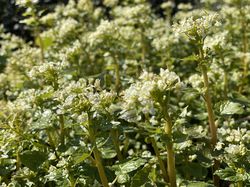 The true wasabi plant (Eutrema japonica), also called Japanese horseradish, is a rare vegetable or spice plant that originated in Japan but is now cultivated worldwide. Everyone who regularly enjoys sushi is familiar with this green, spicy paste that brings tears to the eyes and is often touted as wasabi paste in Europe. But now the frightening truth: if at all, such pastes only include wasabi in the lower single-digit percentage range. The main ingredient is predominantly ordinary horseradish. So read why it is worth producing your own wasabi plants from our wasabi young plants.
The true wasabi plant (Eutrema japonica), also called Japanese horseradish, is a rare vegetable or spice plant that originated in Japan but is now cultivated worldwide. Everyone who regularly enjoys sushi is familiar with this green, spicy paste that brings tears to the eyes and is often touted as wasabi paste in Europe. But now the frightening truth: if at all, such pastes only include wasabi in the lower single-digit percentage range. The main ingredient is predominantly ordinary horseradish. So read why it is worth producing your own wasabi plants from our wasabi young plants.
Wasabi young plants – a plant portrait
The true wasabi – Eutrema japonica – is also called Japanese horseradish. Wild populations of this rare vegetable species can only be found at the edges of streams and rivers in the mountainous regions of the Japanese islands and on the Russian island of Sakhalin. Wasabi is now also cultivated on other continents, especially in Taiwan, Korea, Israel, Thailand and New Zealand.
Particularly the adaptation to these original locations on flowing waters in the mountains ensures that the wasabi plant can develop into a real diva in the home garden but also in plant production. A wasabi plant does not want to be too cold during the winter and not too warm in the summer. It needs a rather humid microclimate in a semi-shady or better fully shady location with a sufficient water supply without waterlogging. These rather high location requirements and the associated rather scarce locations for commercial wasabi cultivation are decisive for the fact that fresh wasabi is quite an expensive affair. Up to 400 €/kg are not uncommon.
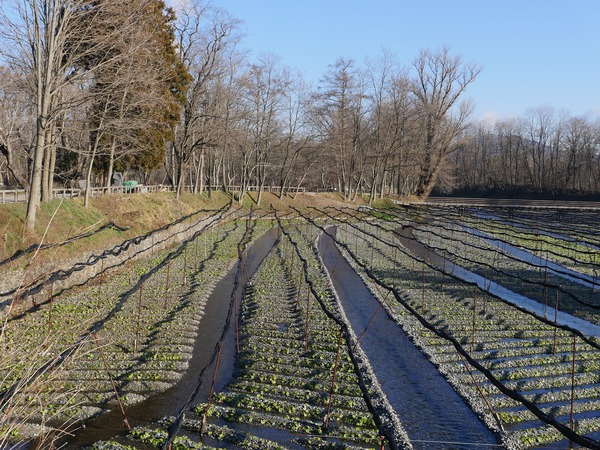
Picture: Wasabi is grown commercially on such gravel banks in the Japanese mountain regions.
This high price is also the reason why we don't really have any real wasabi. And the wasabi pastes and creams sold in grocery stores only have wasabi content in the lower single-digit percentage range, if at all. The pungency usually comes from the horseradish and the green colour is added artificially.
Here is a fun fact: even in Japan, where wasabi is native and where its uses have been discovered, there is not enough suitable cultivation area to meet the domestic demand for fresh wasabi.
In cultivation, a wasabi plant needs about 18 – 24 months until it can be harvested. During this time, the constantly growing leaves form a central shoot axis. This shoot axis can ideally grow over 20 cm high and is ultimately the part of the wasabi plant that is usually harvested and eaten. However, the young leaves and flowers are also edible and add a subtle, spicy note to any salad. The leaves and flowers can be harvested all year round, but never more than 20% of the leaves should be harvested at once, as this would weaken the plant unnecessarily. The shoot axis is harvested only in autumn, when most of the leaves have already fallen off by themselves. For this, however, the entire plant must be uprooted. Then the roots are cut off close to the shoot axis and cleaned with clear water; now the self-harvested wasabi is ready for use.
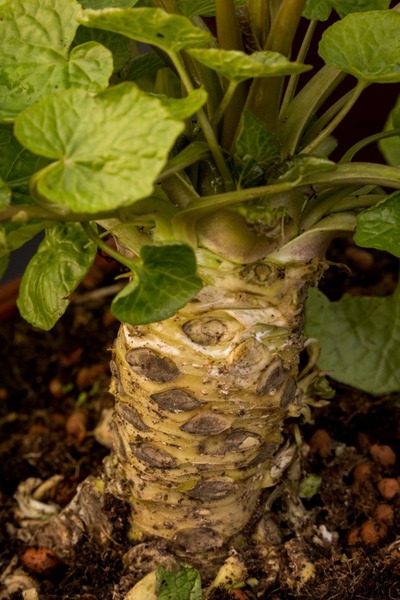
Picture: This is what most people go for in wasabi - the thickened central shoot axis, which is traditionally ground into a fine paste on a ray skin grater.
Wasabi use in the kitchen
In Japan, the country of origin of wasabi, freshly grated wasabi is mainly served with sushi. However, the use of fresh wasabi is not only limited to sushi, ultimately (almost) all fish dishes can be seasoned well with freshly grated wasabi. Basically, wasabi can be used in a variety of different dishes. For very experimental cooks, there is nothing to stop them from using wasabi in desserts.
The wasabi sprouts should always be used fresh and eaten immediately, as this is the only way to fully enjoy the fine sweet taste with the strong spiciness. This is because oxidation processes start in fresh wasabi after about 20 minutes and ensure that the volatile mustard oil gases, which are responsible for the pungency, are broken down.
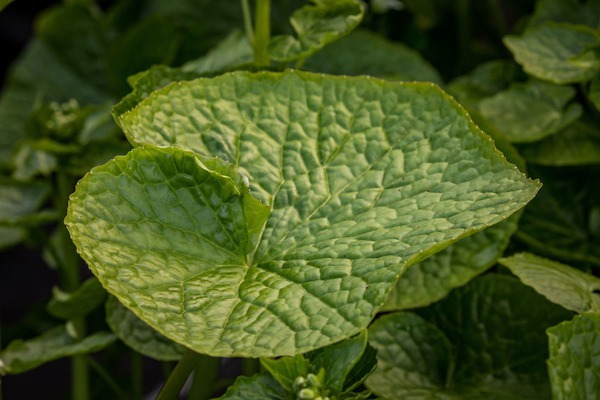
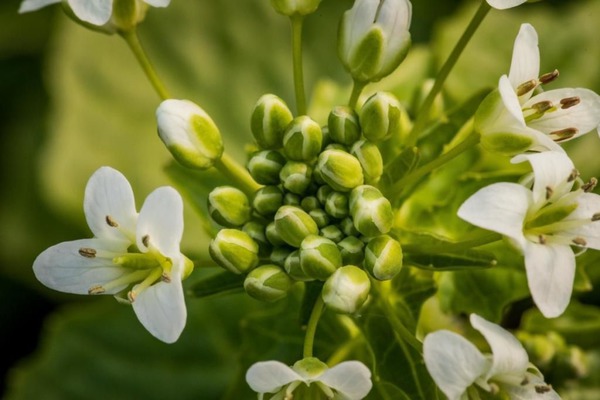
Pictures: Besides the shoot axis, the leaves and flowers of wasabi can also be eaten.
But in addition to the shoot axis, both the leaves and the flowers can be eaten. Both can be used well in salads. The leaves have a subtle aroma and a significantly reduced pungency and add a very interesting flavour component to any salad. Compared to the leaves, the flowers have a much finer, sweeter aroma and only a very subtle pungency. Used as an edible flower decoration, they turn any plate into a real highlight.
Fresh wasabi sprouts can be stored very well in a glass of water in the refrigerator, so this delicious spice is always at hand. However, it is especially important to change the water daily.
The taste of wasabi
So what does real, pure wasabi taste like? The taste of wasabi is often compared to that of horseradish. This comparison is neither correct nor incorrect. Freshly grated wasabi has a harmless, sweet taste at the beginning, but then the volatile mustard oil gases form, which we also know from horseradish. These mustard oil gases rise to the top of the nose, where they stimulate the pain receptors in the nasal mucous membranes and bring tears to your eyes. Horseradish also produces these volatile mustard oils, but instead of the fresh grassy flavours of wasabi, horseradish has those typical earthy flavours that make it so distinctive.
Wasabi in the home garden – cultivation with a challenge
As already described above, the wasabi plant has quite specific site requirements. However, these requirements are mainly important for commercial wasabi cultivation and must be met there. Nevertheless, cultivation in the garden at home in Central Europe is also possible, but there are a few things to consider. Although it is not necessary to live in the mountains next to a mountain stream for successful wasabi cultivation in the home garden, it should be a semi-shaded or even better a fully shaded and deliberately cool location. In addition, a good and sufficient water supply is essential for successful cultivation because the wasabi plant thrives all the better with higher humidity. However, excess water should also be able to drain off well in order to avoid waterlogging.
Basically, wasabi plants are only hardy to a certain extent, but there are also varieties that are more winter hardy than others. Nevertheless, winter protection is important in Central Europe. For this purpose, the wasabi plant is covered with an insulating layer of leaves or straw up to 30 cm thick in October/November, after the last leaves have retracted.
If this is too much work for you, you can also cultivate the wasabi plant as a pot/container plant. To do this, pot the wasabi plant in a container with a minimum volume of 10 litres. It is better to use a humus-rich planting substrate than a pot plant soil. A large saucer, in which there should always be a little water, ensures a sufficient water supply. And to keep the moisture in the pot better, it is important to cover the surface with a loose mulch material. The pot also ensures frost-free overwintering at around 5°C.
Wasabi young plants from Lubera Edibles
With the introduction of our wasabi young plants, we are now able to offer you another tasty vegetable in the EverVeg® range. We are always interested in offering our customers and all interested parties a wide and innovative range of vegetables.
Now some may ask why we include our wasabi young plants in the EverVeg® assortment since the wasabi plants can only be harvested destructively to get to the shoot. This consideration is completely justified and also cannot be dismissed out of hand. Nevertheless, we have decided to classify our wasabi young plants as an EverVeg® since a wasabi plant is quite persistent and it takes at least 18 – 24 months until the shoot is destructively harvested. Of course, the wasabi plant also grows longer if the harvesting of the shoot is dispensed with. In addition, the leaves and flowers can always be harvested during the vegetation periods that the wasabi plant needs in order to form a shoot that is ready for harvesting. And so we are back to a perennial vegetable plant that can be harvested over several years, i.e. the EverVeg®.
The production of wasabi plants in pots
We offer our wasabi young plants exclusively in our 60-cell standard young plant tray, and thus in the same quality and size as our other vegetables in the EverVeg® range. Our wasabi young plants are available in early spring, starting in calendar week 14.

Picture: Wasabi young plants from Lubera Edibles
With the wasabi young plant quality we offer, high-quality sales goods can be produced in just a few weeks, and all pot sizes between 9 cm and 17 cm (C2) are conceivable. Here, too, we advise you to produce a larger sales product, > 1 L (11 – 13 cm pot). By selling larger quantities, you automatically generate a higher-quality plant that stands out visibly in the mass market of annual vegetable plants and is therefore not necessarily comparable in price.
If our wasabi young plants are potted at the beginning of April (week 14), for example, in a 13 cm pot, the wasabi plants can already be ready for sale in mid-May, as long as the production takes place in a moderately tempered greenhouse (12°C – 15°C). It is also possible to grow them in a greenhouse that is kept frost-free, but this can extend the production time until the end of May.
As with the other vegetables, it makes sense to produce not just one type of vegetable, but an entire assortment that is well coordinated.
Our wasabi assortment
Our wasabi young plant assortment currently consists of the wasabi variety 'Matsum'. The 'Matsum' variety is characterised by its higher frost and winter hardiness and is therefore better suited for cultivation in Central Europe. Nevertheless, the wasabi young plant variety 'Matsum' should also be protected in the winter by using foliage or straw.
Advantages of the wasabi 'Matsum'
- Exotic pungency
- Perennial cultivation is possible with winter protection
- Self-sufficiency tastes better than adulterated commercial products

Picture: Wasabi 'Matsum' - plants ready for sale in a 13 cm square pot.
Short description: wasabi young plant 'Matsum'
- Growth: a perennial, deciduous plant; likes cool and shady locations in the garden
- Maturity/harvest: besides the central shoot axis (from which the actual wasabi paste is grated), the leaves and flowers can also be harvested
- Fruits: the young leaves are used (as a seasoning for salads) and the developing central shoot axis (grated as wasabi paste)
- Taste: first a sweet start, then the mustard oils burning in the nose and palate – somewhat borderline and yet – or even more so – unmistakably good! Just typical wasabi!
Order now!
If this exotic vegetable has whetted your appetite, then don't hesitate to order your requirement of wasabi young plants for the next season. Or best of all, order your individual EverVeg® assortment right away.
